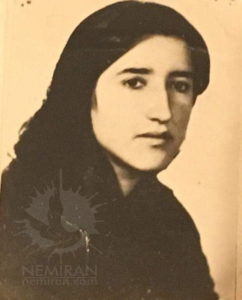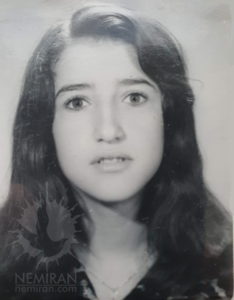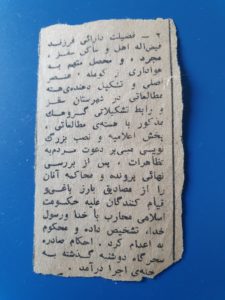With the reopening of schools and educational centers in the fall of 1978, the flame of social uprising rose in Iran more and more and spread all over the rotten foundations of the monarchy system.
The reopening of educational centers gave more impetus to social uprisings. Students, girls and boys, along with other social classes, proceeded determined to the struggle field to end oppression and injustice, and with the desire to achieve dignified human life. The revolution of the oppressed masses overthrew the tyranny in a short time.
Fazilat was one of the thousands of students who, after the opening of schools along with other comrades, walked on the battlefield and participated in demonstrations, rallies and school sit-down strikes in Saqqez in order to fulfill her own aspirations and the desire of masses of the people to eliminate any oppression and to open the horizon of a decent human life for them.

Fazilat Darayi was born on 27.03.1962 in a well-known family in Saqqez. Her mother was named “Khanma Chekola” and a father was named Faizullah. She was the fourth child in the family to grow up in a calm and loving atmosphere. She completed the primary and secondary education in Saqqez. She did not have the opportunity to finish her education, when the government of the Islamic Republic came to power.
From her early childhood and throughout her short life, Fazilat had a great behavior and decency and was very reliable. Fazilat’s youth was firm, calm and dignified. At the beginning of the revolutionary uprising of the people against the Shah’s regime, Fazilat was only 17 years old. She had a significant presence in protests and demonstrations despite her young age.
With the victory of the revolution and the fall of the monarchy, the flower of hope sprouted in the hearts of millions of people thirsting for freedom and equality. The new rulers, riding on the wave of the movement and plundering its achievements, had prepared a sinister and dark destiny for the path of freedom and the whole society.
From the very first months of their rule, conspiracies against the legitimate demands of the people began and attacks on freedom and libertarians began. Over time, the people, especially the freedom fighters, became more and more aware that it was inconceivable to open a clear path from the heart of this dark government.
Kurdistan, which had rightly become a stronghold of struggle and freedom, was one of the first places to be brutally attacked by the central government. In a situation where the combative people of Kurdistan, who, in addition to class and political oppression, also bore the burden of national oppression, did not hesitate to defend their rights, they did not hesitate to start a new round of struggle this time against the new rulers.
Thus a new difficult phase of the struggle began for Fazilat and for thousands of other passionate young people. With the occupation of the cities of Kurdistan by the Islamic Republic, the struggle of Fazilat and her comrades, which had now taken on an organizational form within the framework of the Komala organization, was transformed into a secret struggle.
Fazilat carried out her organizational work and duties in this field immediately to the best of her competence. A young girl at the age of 18 could use the good economic situation of the family to choose a safe and comfortable way to live. However, she became the follower of a way not for herself as a woman, but intended the horizon of a comfortable and humanitarian life for the whole society.

As mentioned, this road was much more difficult by the presence of a big obstacle named the Islamic Republic. Fazilat, like other travelers on this path, was aware of the dangers ahead. She also knew that as a “woman,” a “Kurd,” and especially as a libertarian, none of her aspirations could be realized within the framework of a dark religious government.
A new round of struggle and activity for Fazilat had entered a new phase. As a supporter of the Komala organization, Fazilat operated within an organizational framework that aimed to end all forms of oppression and discrimination, including class oppression, oppression and inequality against women, and national oppression.
Fazilat, along with several other boys and girls in the city, was organized in a sector. In addition to studying and trying to raise the awareness of the members of her sector, she had the duty of distribution of announcements and various organizational publications in the city, especially in the working-class neighborhoods. Writing slogans to expose the regime’s inhumane policies and to encourage people to confront and resist these policies was another part of Fazilat’s and her comrades activities.
These struggles and activities, which took place not only by Komala and its supporters in Kurdistan, but also by many left-wing and democratic parties and organizations, both in Kurdistan and throughout Iran, put the regime in serious danger. Hence, a great repressive conspiracy was hatched. Initially, it attacked universities that were largely under the hegemony of leftist and socialist organizations, and gradually expanded its attacks on other organizations, parties, and combatants.
A large wave of arrests of libertarians began in spring of 1981. Two months later, the regime massacred tens of thousands of freedom fighters by executing and massacring detainees. The wave of arrests and executions also swept through Kurdistan.
In the summer of 1981, following a plan to arrest the opposition combatants, Fazilat was arrested by the Intelligence Service of the Revolutionary Guards and was sent to Sanandaj prison. During her imprisonment, which did not last more than a few months, her mother, “Khanma Chekola”, went to Sanandaj several times to visit her. She returned to Saqqez with a broken heart each time, after repeated insults and disrespectful treatment.

Finally, in the first days of December of the same year, and following the execution and mass murder of political prisoners, the regime of the Islamic Republic of Iran also carried out the extremely inadmissible execution of Fazilat and dried the bud of her dreams and aspirations. The regime, like thousands of other executions, did not return Fazilat’s body to her family.
According to criminal regime officials, her body was buried in a place known as “Shaitanabad” near the city of Qorveh.
The regime’s newspapers wrote in a brief statement: “She was executed because of collaborating with the Komala, a counter-revolutionary group, distributing Komala’s flyers and encouraging people to revolt against the Islamic Republic”. Undoubtedly, this brief news confirms the fact that Fazilat and thousands of other young people were executed by the Islamic Republic only for expressing their opinions and because of their political views.
Pressure was continued on Fazilat’s family for many years after her execution. Her family and several other families were deported from Saqez to the Fooladshahr camp in Isfahan on March 12th 1982 just a few months after Fazilat’s execution.

